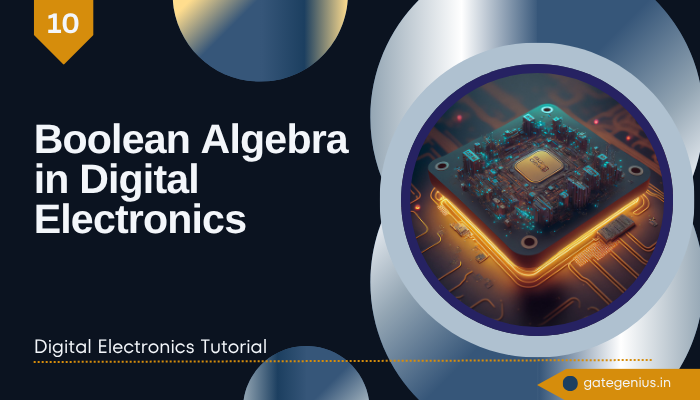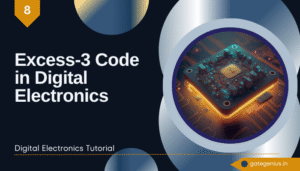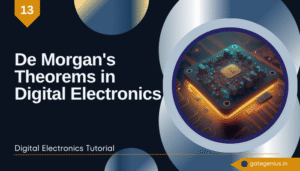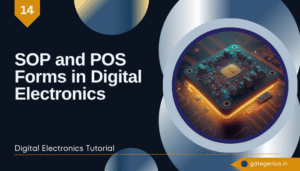Boolean Algebra is the backbone of digital electronics, forming the basis for designing and analyzing digital circuits. It deals with binary values (0 and 1) and logical operations, helping engineers simplify complex logical expressions and optimize circuit design.
In this blog, we will explore Boolean Algebra in digital Electronics, its rules, laws, operations, and applications in digital electronics.
What is Boolean Algebra?
Boolean Algebra is a branch of mathematics that deals with binary variables and logical operations. It was introduced by George Boole in 1854 and is widely used in computer science, electrical engineering, and logic circuit design.
Unlike traditional algebra, which operates on real numbers, Boolean Algebra works with only two values:
- 0 (False or LOW)
- 1 (True or HIGH)
These values are manipulated using logical operations to represent and simplify digital circuits.
Basic Boolean Operations
1. AND (.) Operation in Boolean Algebra
- Symbol:
.(Dot) or Multiplication - Expression:
X = A . BorX = AB
Truth Table:
| A | B | X = A . B |
|---|---|---|
| 0 | 0 | 0 |
| 0 | 1 | 0 |
| 1 | 0 | 0 |
| 1 | 1 | 1 |
Explanation:
In Boolean Algebra in Digital Electronics, the AND operation produces a true output (1) only when both inputs are 1. It is similar to multiplication in algebra, where:
0 . 0 = 00 . 1 = 01 . 0 = 01 . 1 = 1
This logic gate is widely used in digital circuits to allow signals to pass only when certain conditions are met. AND is a fundamental building block in digital electronics and helps implement conditional logic.
2. OR (+) Operation in Boolean Algebra
- Symbol:
+(Plus) or Addition - Expression:
X = A + B
Truth Table:
| A | B | X = A + B |
|---|---|---|
| 0 | 0 | 0 |
| 0 | 1 | 1 |
| 1 | 0 | 1 |
| 1 | 1 | 1 |
Explanation:
In Boolean Algebra in Digital Electronics, the OR operation results in true (1) if at least one input is 1. It is similar to addition in algebra, but in Boolean logic:
0 + 0 = 00 + 1 = 11 + 0 = 11 + 1 = 1(Note: In Boolean algebra, 1 + 1 is still 1)
This logic gate is used when any one of multiple conditions can be true for the output to be true. OR gates are essential in digital circuits for implementing decision-making operations.
3. NOT (¬) Operation in Boolean Algebra
- Symbol:
¬(or an overline on the variable) - Expression:
X = ¬AorX = A̅
Truth Table:
| A | X = ¬A |
|---|---|
| 0 | 1 |
| 1 | 0 |
Explanation:
The NOT operation in Boolean Algebra in Digital Electronics is known as an inverter. It flips the input:
- If
A = 0, then¬A = 1 - If
A = 1, then¬A = 0
This is a unary operation (works on a single input). The NOT gate is used when the opposite of a signal is required, and it plays a vital role in creating complex digital circuits like NAND, NOR, and XNOR.
Applications of Boolean Algebra in Digital Electronics
Boolean Algebra in Digital Electronics plays a crucial role in designing and analyzing various components of digital systems. Below are the key applications:
1. Logic Gate Design
Boolean Algebra in Digital Electronics is fundamental in the design and implementation of basic logic gates such as AND, OR, NOT, NAND, NOR, XOR, and XNOR.
- Each gate operates based on Boolean expressions that define their behavior.
- Engineers use Boolean equations to model real-world logic and implement them using integrated circuits (ICs).
- For example, a security system may use Boolean logic like:
Alarm = DoorOpen + WindowOpen.
Thus, Boolean Algebra helps translate logical conditions into hardware-level logic circuits.
2. Simplification of Digital Circuits
One of the most powerful applications of Boolean Algebra in Digital Electronics is simplification.
- Complex Boolean expressions can be minimized using Boolean laws and theorems (like De Morgan’s Theorem, Distribution, etc.).
- Simplified logic reduces the number of gates, inputs, and interconnections, leading to:
- Lower cost
- Reduced power consumption
- Higher processing speed
- Tools like Karnaugh Maps (K-Maps) and Boolean identities help in optimizing logic expressions.
This optimization is essential in designing efficient and compact digital systems.
3. Computer Arithmetic
Boolean Algebra in Digital Electronics is the backbone of binary arithmetic operations in computers.
- It is used to design components like:
- Adders (Half and Full Adders)
- Subtractors
- Multipliers
- Comparators
- Arithmetic Logic Units (ALUs)
- These units perform arithmetic and logical operations on binary data using Boolean logic.
Without Boolean Algebra, implementing basic operations in digital processors would be impossible.
4. Memory Circuits
In digital systems, Boolean Algebra in Digital Electronics is used to design and control memory components like:
- Flip-Flops (used for storing 1-bit of data)
- Registers (used to store multi-bit values)
- Random Access Memory (RAM) and Read-Only Memory (ROM)
Boolean expressions define the operation of latching, setting, resetting, and toggling the memory elements. These circuits form the core of data storage and retrieval mechanisms in all computing devices.
5. Control Systems
Control systems in automation, robotics, microcontrollers, and processors are all built upon Boolean Algebra in Digital Electronics.
- Logical decisions like ON/OFF, start/stop, or enable/disable are modeled using Boolean expressions.
- For example, in a washing machine, the logic may be:
StartCycle = DoorClosed . WaterFilled . TimerSet - Complex control units in processors and embedded systems use Boolean logic to control sequences and operations.
Boolean Algebra makes it possible to implement logical decision-making in machines, forming the core of digital automation and control.
Frequently Asked Questions?
Q1. What is Boolean Algebra?
A1. Boolean Algebra is a mathematical system used to simplify and analyze digital circuits using binary values (0 and 1).
Q2. Who introduced Boolean Algebra?
A2. Boolean Algebra was introduced by George Boole in 1854.
Q3. What are the three basic Boolean operations?
A 3. a) AND (⋅) – Multiplication operation b.) OR (+) – Addition operation c.) NOT (’) – Complementation operation
Q4. Where is Boolean Algebra used?
A4) a.) Simplification of logic circuits b.) Design of digital systems like adders, multiplexers, and memory units c.) Programming in low-level languages
Conclusion
Boolean Algebra in Digital Electronics is not just a theoretical concept; it is the foundation of modern digital technology. From the smallest logic gate to complex processors and control systems, Boolean logic is applied at every stage of digital circuit design. It empowers engineers and students to understand how decisions are made inside a computer using binary values (0s and 1s).
I hope you understand Boolean Algebra in Digital Electronics. So don’t forget to share this post with friends and anyone preparing for the GATE, UGC NET exams, or studying at the university
Would you like a deeper dive into logic gate implementation or circuit design? Let me know in the comments!



